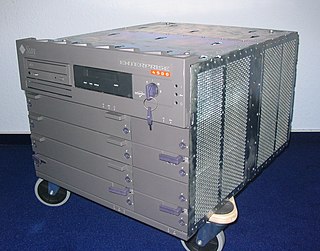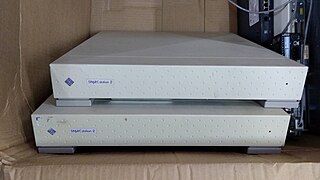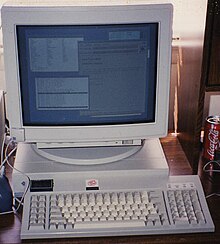
Sun Microsystems, Inc. was an American technology company that sold computers, computer components, software, and information technology services and created the Java programming language, the Solaris operating system, ZFS, the Network File System (NFS), and SPARC microprocessors. Sun contributed significantly to the evolution of several key computing technologies, among them Unix, RISC processors, thin client computing, and virtualized computing. Notable Sun acquisitions include Cray Business Systems Division, Storagetek, and Innotek GmbH, creators of VirtualBox. Sun was founded on February 24, 1982. At its height, the Sun headquarters were in Santa Clara, California, on the former west campus of the Agnews Developmental Center.

SBus is a computer bus system that was used in most SPARC-based computers from Sun Microsystems and others during the 1990s. It was introduced by Sun in 1989 to be a high-speed bus counterpart to their high-speed SPARC processors, replacing the earlier VMEbus used in their Motorola 68020- and 68030-based systems and early SPARC boxes. When Sun moved to open the SPARC definition in the early 1990s, SBus was likewise standardized and became IEEE-1496. In 1997 Sun started to migrate away from SBus to the Peripheral Component Interconnect (PCI) bus, and today SBus is no longer used.

Sun Enterprise is a range of UNIX server computers produced by Sun Microsystems from 1996 to 2001. The line was launched as the Sun Ultra Enterprise series; the Ultra prefix was dropped around 1998. These systems are based on the 64-bit UltraSPARC microprocessor architecture and related to the contemporary Ultra series of computer workstations. Like the Ultra series, they run Solaris. Various models, from single-processor entry-level servers to large high-end multiprocessor servers were produced. The Enterprise brand was phased out in favor of the Sun Fire model line from 2001 onwards.

Floating Point Systems, Inc. (FPS), was a Beaverton, Oregon vendor of attached array processors and minisupercomputers. The company was founded in 1970 by former Tektronix engineer Norm Winningstad, with partners Tom Prince, Frank Bouton and Robert Carter. Carter was a salesman for Data General Corp. who persuaded Bouton and Prince to leave Tektronix to start the new company. Winningstad was the fourth partner.

The SPARCstation 1 is the first of the SPARCstation series of SPARC-based computer workstations sold by Sun Microsystems. The design originated in 1987 by a Sun spin-off company, Unisun, which was soon re-acquired. The SPARCstation 1 has a distinctive slim enclosure and was first sold in April 1989, with Sun's support ending in 1995.

The Sun Ultra series is a discontinued line of workstation and server computers developed and sold by Sun Microsystems, comprising two distinct generations. The original line was introduced in 1995 and discontinued in 2001. This generation was partially replaced by the Sun Blade in 2000 and that line was in itself replaced by the Sun Java Workstation—an AMD Opteron system—in 2004. In sync with the transition to x86-64-architecture processors, in 2005 the Ultra brand was later revived with the launch of the Ultra 20 and Ultra 40, albeit to some confusion, since they were no longer based on UltraSPARC processors.

MBus is a computer bus designed and implemented by Sun Microsystems for communication between high speed computer system components, such as the central processing unit, motherboard and main memory. SBus is used in the same machines to connect add-on cards to the motherboard.

The SPARCstation 20 or SS20 is a discontinued Sun Microsystems workstation introduced in March 1994 based on the SuperSPARC or hyperSPARC CPU. It is one of the last models in the SPARCstation family of Sun "pizza box" computers, which was superseded by the UltraSPARC design in 1995.

The SPARCstation 10 is a workstation computer made by Sun Microsystems. Announced in May 1992, it was Sun's first desktop multiprocessor. It was later replaced with the SPARCstation 20.

SPARCstation 5 or SS5 is a workstation introduced by Sun Microsystems in March 1994. It is based on the sun4m architecture, and is enclosed in a pizza-box chassis. Sun also offered a SPARCserver 5 without a framebuffer. A simplified, cheaper version of the SS5 was released in February 1995 as the SPARCstation 4. Sun also marketed these same machines under the "Netra" brand, without framebuffers or keyboards and preconfigured with all the requisite software to be used as web servers. An estimated 400,000+ SPARCstation 5s were sold.
Sun-4 is a series of Unix workstations and servers produced by Sun Microsystems, launched in 1987. The original Sun-4 series were VMEbus-based systems similar to the earlier Sun-3 series, but employing microprocessors based on Sun's own SPARC V7 RISC architecture in place of the 68k family processors of previous Sun models.
The Cray Superserver 6400, or CS6400, is a discontinued multiprocessor server computer system produced by Cray Research Superservers, Inc., a subsidiary of Cray Research, and launched in 1993. The CS6400 was also sold as the Amdahl SPARCsummit 6400E.

The SPARCstation 2, or SS2 is a SPARC workstation computer sold by Sun Microsystems. It is based on the sun4c architecture, and is implemented in a pizza box form factor.

The Ultra 1 is a family of Sun Microsystems workstations based on the 64-bit UltraSPARC microprocessor. It was the first model in the Ultra series of Sun computers, which succeeded the SPARCstation series. It launched in November 1995 alongside the MP-capable Ultra 2 and shipped with Solaris 2.5. It is capable of running other operating systems such as Linux and BSD.

The Sun Microsystems Ultra 80 is a computer workstation that shipped from November 1999 to 2002.

Sun4d is a computer architecture introduced by Sun Microsystems in 1992. It is a development of the earlier Sun-4 architecture, using the XDBus system bus, SuperSPARC processors, and SBus I/O cards. The XDBus was the result of a collaboration between Sun and Xerox; its name comes from an earlier Xerox project, the Xerox Dragon. These were Sun's largest machines to date, and their first attempt at making a mainframe-class server.

The SPARCclassic is a workstation introduced by Sun Microsystems in November 1992. It is based on the sun4m architecture, and is enclosed in a lunchbox chassis. It shares the code name Sunergy with the SPARCclassic X, SPARCstation LX, and SPARCstation ZX. It was replaced by the SPARCstation 4 in February 1994.
The SPARCstation LX is a workstation that was designed, manufactured, and sold by Sun Microsystems. Introduced in November 1992, it is based on the sun4m architecture and enclosed in a lunchbox chassis. It shares the code name Sunergy with the low-end range of SPARCclassic, SPARCclassic X, and SPARCstation ZX.

The SPARCstation IPC is a workstation sold by Sun Microsystems, introduced July 1990. It is based on the sun4c architecture, and is enclosed in a lunchbox chassis.

The SPARCstation IPX is a workstation that was sold by Sun Microsystems, introduced July 1991. It is based on the sun4c architecture, and is enclosed in a lunchbox chassis.




















